Apistogramma borellii
Umbrella Cichlid
Classification
Order: Perciformes Family: Cichlidae
Distribution
Native to southern Brazil, Paraguay and northern Argentina. It occurs in creeks and tributaries of both the Rio Paraguay and lower Rio Paraná basins.
Habitat
Described from ‘Carandasiñho’, nowadays spelled Carand`zinho in the rio Paraguay basin, Mato Grosso state, Brazil. Currently accepted to have a wider distribution throughout much of the rio Paraguay, lower rio Paraná and Uruguay systems in southern Brazil, Paraguay, Argentina and Uruguay.
Maximum Standard Length
Aquarium SizeTop ↑
Base dimensions around 45 ∗ 30 cm are acceptable for a single pair with a group requiring significantly larger quarters.
Maintenance
Provided adequate cover and structure is available this species is unfussy with regards to décor with ceramic flowerpots, lengths of plastic piping and other artificial materials all useful additions. A more natural-looking arrangement might consist of a soft, sandy substrate with wood roots and branches placed such a way that plenty of shady spots and caves are formed.
The addition of dried leaf litter (beech, oak or Ketapang almond leaves are all suitable) would further emphasise the natural feel and with it bring the growth of beneficial microbe colonies as decomposition occurs. These can provide a valuable secondary food source for fry, while the tannins and other chemicals released by the decaying leaves aid in simulation of naturalistic conditions. Leaves can be left in the tank to break down fully or removed and replaced every few weeks. A net bag filled with aquarium-safe peat can also be added to the filter or suspended over the edge of thetank.
Fairly dim lighting is recommended and plant species from genera such as Microsorum, Taxiphyllum, Cryptocoryne andAnubias are best since they will grow under such conditions. A few patches of floating vegetation to diffuse the light even further may also prove effective. Filtration, or at least water flow, should not be very strong and very large water changes are best avoided with 10-15% weekly adequate provided the tank is lightly-stocked.
Water Conditions
Temperature: 20 – 26 °C
pH: Commercially-produced fish are relatively unfussy but wild populations have been collected from habitats with recorde values over the range 5.0 – 8.0 depending on locality and may have more specific requirements.
Hardness: 18 – 268 ppm, again somewhat dependant on origin.
Diet
Primarily carnivorous and apparently feeds mostly on benthic invertebrates in nature. In the aquarium live and frozen foods such as Artemia, Daphnia and chironomid larvae (bloodworm) should be offered regularly although most specimens will also learn to accept dried alternatives with pelleted products generally preferred to flake.
Behaviour and CompatibilityTop ↑
Captive-raised fish are the recommended choice for the general community aquarium. Wild examples are best maintained alone or with small ‘dither’ fishes such as Nannostomus spp., and ideally should not be mixed with other Apistogramma.
Sexual Dimorphism
Males are larger, more colourful and develop more extended fins than females.
Reproduction
Substrate spawner which normally lays its eggs in crevices or cavities among the décor. The female is responsible for post-spawning care of eggs and fry. The female is responsible for post-spawning care of eggs and fry and in smaller aquaria the male may need to be removed as she may become hyper-aggressive.
NotesTop ↑
Numerous ornamental forms of this species have been selectively-bred for the aquarium trade. It has also been assigned the ‘A’ number A234 under the DATZ system with possibly conspecific, related forms similarly numbered A103, A104, and A105 depending on locality.
The genus Apistogramma is among the most speciose of South American cichlid genera with around 70 species valid at present but many more awaiting description. In addition many species exist in two or more geographical colour forms which may or may not turn out to be distinct in the future. Hobbyists tend to label these with collection data if available in order to avoid mixing them and the potential of hybridisation.
Member species have also been organised into a series of species lineages, complexes and groups by authors in order to better separate them. Such lists have been augmented by fish that have appeared in the aquarium trade and are in a state of near-constant flux. The A. borelli group, for example, is ordered within the larger A. regani lineage.
Kullander (1998) conducted a morphology-based phylogenetic study in which the neotropical family Cichlidae was divided into six subfamilies of which the putative subfamily Geophaginae contained 16 genera divided among three ‘tribes’:
Acarichthyini – Acarichthys and Guianacara.
Crenicaratini – Biotoecus, Crenicara, Dicrossus and Mazarunia.
Geophagini – Geophagus, Mikrogeophagus, ‘Geophagus‘ brasiliensis group, ‘Geophagus‘ steindachneri group,Gymnogeophagus, Satanoperca, Biotodoma, Apistogramma, Apistogrammoides and Taeniacara.
Later molecular studies by Farias et al. (1999, 2000, 2001) resulted in the additions of Crenicichla and Teleocichla to the Geophaginae, a result supported by López-Fernández et al. (2005) who conducted the most detailed molecular analysis of the grouping to date including 16 of the 18 genera and 30 species. However their conclusions regarding interrelationships between genera did vary somewhat from previous hypotheses and can be summarised by the following loosely-defined groups:
– a weakly-supported sister group relationship between Acarichthys and Guianacara.
– a well-supported “Satanoperca clade” comprising Satanoperca, Apistogramma, Apistogrammoides and Taeniacara.
– a “big clade” with Geophagus, Mikrogeophagus, ‘Geophagus‘ brasiliensis group, ‘Geophagus‘ steindachneri group,Gymnogeophagus, Biotodoma, Crenicara and Dicrossus.
– a “crenicarine clade” with Biotoecus and Crenicichla.
No representatives of Teleocichla or Mazarunia were included in the study but the former is well-established as sisterto Crenicichla while the latter has grouped closely with Dicrossus and Crenicara in earlier works. The other main conclusions of the paper are confirmation that Geophaginae is a monophyletic group exhibiting strong signs of having undergone rapid adaptive radiation (diversification of a species or single ancestral type into several forms that are each adaptively specialised to a specific environmental niche).
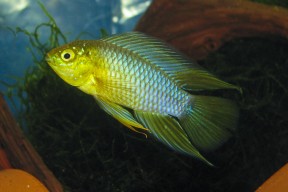

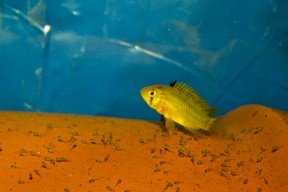
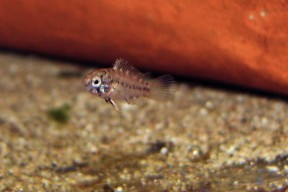
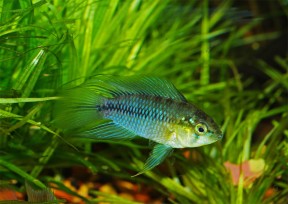
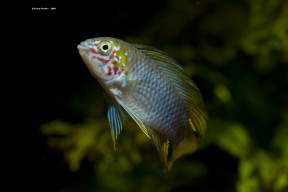
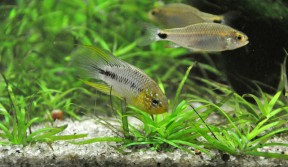
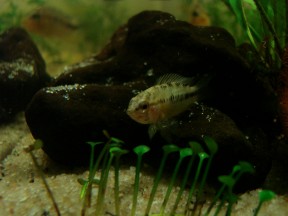


December 4th, 2012 at 12:32 pm
Could you give me more information about A.Borellii’s breeding?
Thank You Very Much
December 4th, 2012 at 3:22 pm
Hi bbetta, I think you’d have more chance asking this question in our ‘Questions and Answers’ section, or directly on the forum. These comments sections on species page are really intended for people to add information about a species. 🙂
December 4th, 2012 at 7:06 pm
Ok Thank You! 🙂
March 20th, 2014 at 6:58 pm
Does anybody have information about sympathetically occurring species; characins for example?
March 20th, 2014 at 7:00 pm
I meant to spell Sympatric species. Darn auto correct spelling!
March 24th, 2014 at 1:13 pm
Borellii are easy to breed, tolerant of a range of temperatures. They seem to have quite a wide distribution, but Aphyocharax rathbuni seems to share at least some of the range. Many of the paleatus group Corydoras woudl suit, as would Ancistrus Sp. “Paraguay” which is available from specialist retailers. You’ll probably get more views if you post this on the forum TBH.
March 3rd, 2015 at 9:10 am
Personally, I wouldn’t keep a breeding pair in anything smaller than 60*30 cm (while the article says 45∗30 cm is fine). Even in a 60*30, the female would chase the male away and sometimes even nipped his fins.
Also be wary of fin nipping tetras. I used to keep my pair with neons (group of 16), then ambers (group of 14). Both species nipped the long anal and dorsal fins.
Mods, if you need more dwarf cichlid pictures, I have some of A. borellii and Nannacara anomala.
January 5th, 2016 at 11:05 pm
‘ello! Just wanted to mention that A. borellii is one of the few cichlids that doesn’t need tropical temps…these cichlids have been found in water as cool as the high 30’s fahrenheit!
An article on apistos mentioning this: http://www.dwarfcichlid.com/Apistogramma_borellii.php
A forum post on the apistogramma forum mentioning the same thing; http://www.apistogramma.com/forum/threads/ideal-water-temp-for-incubation.4091/
Not to say they should be kept at such cool temps…just that they should be fine without a heater in most homes (where the temp should stay above 60 f). Always a plus 🙂